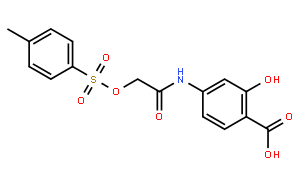| BT474R |
Function Assay |
50 μM |
10-60 d |
|
inhibits STAT3 activity |
25327561 |
| NCI-N87R |
Function Assay |
50 μM |
10-60 d |
|
inhibits STAT3 activity |
25327561 |
| GH3 |
Growth Inhibition Assay |
50-125 μM |
72 h |
|
attenuates the cell growth in a dose-dependent manner |
25774503 |
| GC |
Growth Inhibition Assay |
50-125 μM |
72 h |
|
attenuates the cell growth in a dose-dependent manner |
25774503 |
| H460 |
Apoptosis Assay |
100Â nM |
24Â h |
|
induces cell apoptosis co-treated with BEZ235 |
24472538 |
| A459 |
Apoptosis Assay |
100Â nM |
24Â h |
|
induces cell apoptosis co-treated with BEZ235 |
24472538 |
| H460 |
Apoptosis Assay |
100Â nM |
24Â h |
|
enhances cell death co-treated with LY294002 |
24472538 |
| MT-2 |
Apoptosis Assay |
75-300 μM |
24/48 h |
|
suppresses cell proliferation in a dose-dependent manner and induces cell apoptosis |
24090995 |
| HUT-102 |
Apoptosis Assay |
75-300 μM |
24/48 h |
|
suppresses cell proliferation in a dose-dependent manner and induces cell apoptosis |
24090995 |
| U373 |
Growth Inhibition Assay |
125 μM |
24 h |
DMSO |
disrupts STAT3 signaling and proliferation |
24070820 |
| T-cell |
Growth Inhibition Assay |
|
|
|
IC50=50 μM |
24068731 |
| H1299 |
Function Assay |
50/100 μM |
48 h |
|
suppresses miR-92a expression dose-dependently |
23820254 |
| H460 |
Function Assay |
50/100 μM |
48 h |
|
inhibits the Stat3C increased miR-92a expression |
23820254 |
| PLC/PRF/5 |
Growth Inhibition Assay |
100 nM |
48 h |
DMSO |
inhibits the IL-6 stimulation promoted cell proliferation |
23364389 |
| Huh7 |
Growth Inhibition Assay |
100 nM |
48 h |
DMSO |
inhibits the IL-6 stimulation promoted cell proliferation |
23364389 |
| HUVEC |
Function Assay |
0.5-20 μM |
24 h |
DMSO |
suppresses the hypoxia-induced accumulation of HIF-1α |
21523559 |
| U-373 MG |
Cytotoxicity Assay |
3/10 μM |
24 h |
|
reduces FN-γ-induced cell neurotoxicity |
20888416 |
| MDA-MB-231 |
Growth Inhibition Assay |
|
72 h |
|
IC50ï¼100 μM |
20072652 |
| SK-BR-3 |
Growth Inhibition Assay |
|
72 h |
|
IC50ï¼100 μM |
20072652 |
| PANC-1 |
Growth Inhibition Assay |
|
72 h |
|
IC50ï¼100 μM |
20072652 |
| HPAC |
Growth Inhibition Assay |
|
72 h |
|
IC50ï¼100 μM |
20072652 |
| U87 |
Growth Inhibition Assay |
|
72 h |
|
IC50=55.1 μM |
20072652 |
| U373 |
Growth Inhibition Assay |
|
72 h |
|
IC50=52.5 μM |
20072652 |

 COA
COA MSDS
MSDS HPLC
HPLC NMR
NMR